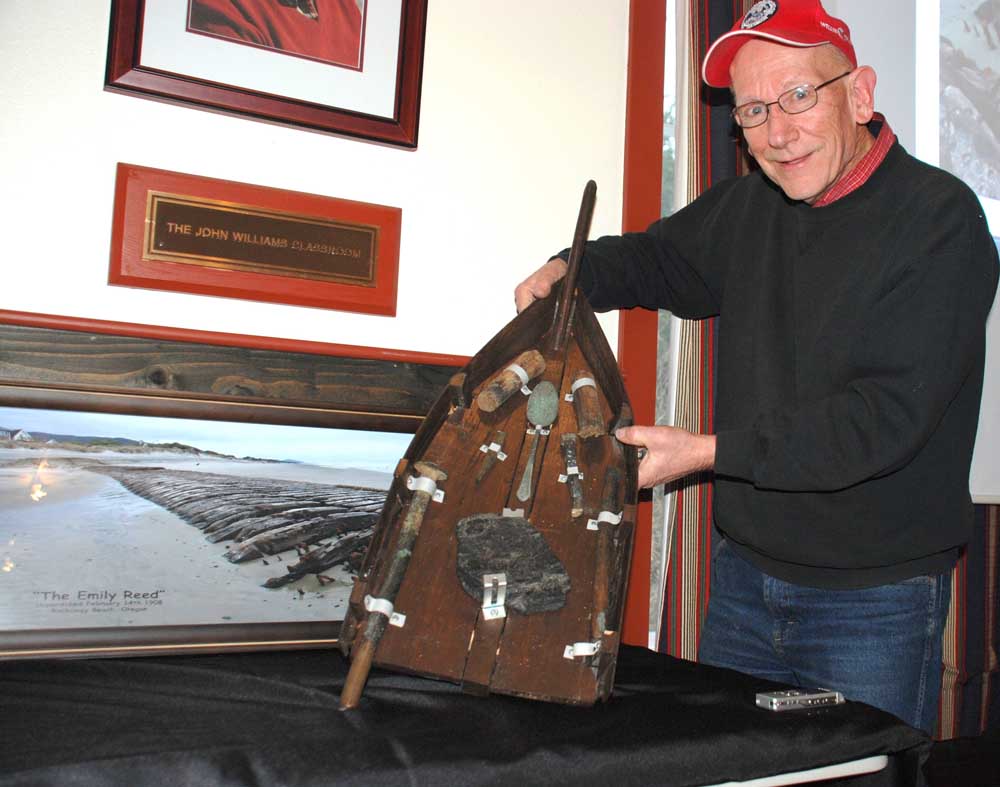Wreck of the Emily Reed
Published 3:57 pm Wednesday, February 20, 2019

- Don Best, a Rockaway resident who has become an authority on the Emily Reed shipwreck, shows a slide of the ship before it ran aground on what is now Rockaway Beach in 1908.
The schooner the Emily Reed, carrying 2,110 tons of coal, set sail from New South Wales, Australia, and headed to Bristol Bay, Alaska, in 1907. But she never reached her destination.
Instead, on Valentine’s Day, 1908, she capsized on Rockaway Beach. And, 111 years later, parts of the ship remain.
Documentary photographer Don Best has been fascinated with the shipwreck since his parents took him as an 18-month-old child in the mid-1940s to see the ship’s “rib cage” lying on the beach, uncovered by shifting sands.
“We know there are at least four sections of the ship in different sections of Rockaway Beach,” Best told an audience at the Cannon Beach History Center.
The Feb. 7 lecture was the second in a series offered by the history center.
The area where the ship ran aground was known as Garibaldi Beach. “It was an isolated beach,” Best said. “There were no roads, nothing there. Just a few homesteaders lived in that area.”
Built in 1880, in Waldoboro, Maine, the ship measured 209 feet long, 40 feet wide and 24 feet deep. Clad underneath with copper sheathing, the Emily Reed was one of the fastest ships of its size, Best said.
By the time she made the trip from Australia, the ship was 28 years old. “She was an old girl,” Best said. “She had been through a lot of storms.”
It was 102 days out from Australia, a month overdue by the time it reached the Oregon coast. While sailing in rain and dense fog at 1 a.m. Feb. 14, 1908, she ran aground.
“She was sailing north past the Tillamook area and was getting close in,” Best said. “The captain thought he was 60 miles out. He made a right turn because he thought he was at the latitude for the Tillamook Rock Light House.”
As soon as it turned, it slammed into the beach at high tide. The whole bow broke off, and the ship listed to the left.
One lifeboat went over the side, and four crewmen jumped into it. “Big high breakers turned it over, and they all drowned,” Best said.
A second lifeboat reached Neah Bay, 200 miles north, with the first mate, two crewmen and the body of the cook, who died on the way.
Altogether eight seamen died and three survived. The captain and his wife survived after jumping from the ship into knee-high water the day after the wreck.
Best read a newspaper story, published in 1953, in which the writer who had witnessed the shipwreck at the time, told of a coal pile two stories high on the ship’s remains and “great quantities of coal strewn on the beach.”
“It was a scene I shall never forget,” the writer continued. “Tons and tons of coal piled high in the surf. Everywhere was wreckage.”
The shipwreck now rests 35 paces in front of the Silver Sands Hotel in Rockaway. As a child, Best, who lived nearby, would scramble on the ship’s rib cage – consisting of 150 oak timbers — when it was exposed.
In 1951 when he was 8, he discovered an air pocket under the rib cage and explored what was left of the ship’s interior.
“I’m on my belly, and I can’t raise my head, and I’m thinking, ‘No one has seen this side of the ship since 1908,’” Best said.
He found the ship’s whistle, which he blew to begin his lecture. The shrill, loud whistle would have been heard all over the long ship, Best said.
As he grew up, Best continued to research the ship’s history and is now an authority on the shipwreck of the Emily Reed. His photos, collected news stories and artifacts are included in his lectures, which he sprinkles liberally with humor and spontaneous comments.
His enthusiasm for discussing the shipwreck engaged the audience that packed the history center.
“I didn’t script this out,” Best explained about his unstructured presentation, “because I want to be just as excited as you about what comes out of my mouth.”



